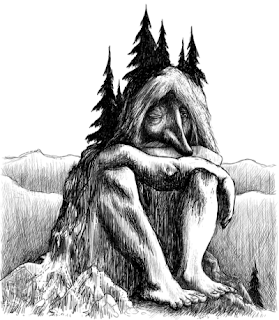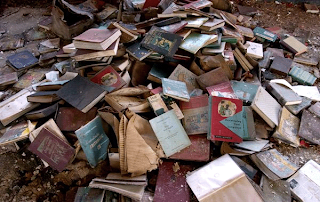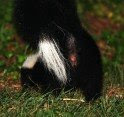Unfettering my imagination
Joan Didion once said, “Writing nonfiction is more like sculpture, a matter of shaping the research into the finished thing.”
I’m trying to figure out when she meant by that, since to me all writing is shaping something into the finished thing. And both my novels — fiction, obviously — have taken considerable research.
Even short stories, which may not take much research, certainly take shaping. Tons of it, in fact, since the short story form is all about economy, where anything superfluous sticks out like stone bunny ears over the head of the Venus de Milo. Crafting a decent short story involves chipping away here and there, edging out a line from the block of an idea, shaving, sanding, until only the essential remains.
Okay, I’ll admit — now that I’m writing a Real Historical Novel (you can’t get much more historical than the 7th century), however, we’re talking GIGANTIC, ENORMOUS research.
What the inside of my head now looks like
Historical, archaeological, ecclesiastic, literary, cultural, philosophical, theological — RESEARCH. It feels less like sculpture than it does like earthmoving, only with a fork instead of a back hoe. Don’t misunderstand me, I love reading The Venerable Bede, The Prose and Poetic Eddas, Beowulf, books on leechcraft, dress, food, farming, warfare, mead halls, crafts and conversion. I really dig reading The Heliand, the lives of the saints, The Rise of Western Christendom, works on the northern mysteries, myths and symbols, lost gods, the role of women, histories of the various kingdoms – all those Edwins, Aelethreds, Ethelbergas, Ethelfriths, Oswalds, Oswys and Eanfleds. And don’t get me started on the runes, the horned god, the smith god, Woden vs Odin, Thor vs Thunor!
But research, damn it, is interfering with my perspective. I mean, before I went on my month long “Anglo-Saxon Forced March” research trip to Britain and Scotland, I had a pretty good idea where this new novel was going, based on my utter lack of knowledge – reinforced by all of the above reading.
And then I learned A GREAT PILE OF FACTS, none of which helped the plot one iota. Okay, I did learn many helpful things – no rabbits, for example. (Although there were hares, and that may seem, to many city folk, like splitting hairs – oh, dear. Pardon.) Also no foxes. No women on the Holy Island Lindisfarne during the time of Aidan’s monastery. Houses were whitewashed inside and out. Carrots were white, not orange. Anglo-Saxons didn’t live in muddy pits and they were NOT all covered in shite, a la Monty Pythons.
Shite-covered peasants. Not quite dead yet.
Then, interwoven with the facts, are the opinions. The great palace at Yeavering was really just a transit camp. No, Yeavering was an active part of the royal estates – with a majestic hall. St. Hilda was married. No, absolutely a virgin. There was no difference between the early Celtic church and the Roman church. Rubbish – they were theologically in great opposition. The king married at York. We have no idea where the king married.
Oy. Well, you get the idea. The bottom line is that, while historical authenticity is important, and if I say the queen’s name was Cindy and rabbits appear everywhere in the text people will probably not find the work credible, still, there is a point where the enormous weight of history, hunkers over everything like a miserable troll.
Over-Researched – The Most Miserable Troll
Every time I’ve put away my writing in the past few days, I find myself saying, “I don’t have a clue what I’m doing.” And then the skunk of self-doubt starts to stink up the place. When this happens, my mind begins to go to bad places, and it stays there, circling around, tail lifted, spraying everything in sight. It can get pretty funky in here.
Le Stinky Skunk-butt
And then, this afternoon, I remembered what I love most about being a fiction writer – I can live in my imagination. I can create a world, and if I create it well, you – the reader – will believe in it. I am, after all, working in metaphor, in symbol. I use these metaphors and symbols – these characters and landscapes, these situations and responses – in order to explore a question. I am not writing a history book. Rather, I am using a particular time in history to discover what I may think about a particular subject. In this case, the subject I’m rolling around in my mind is faith, and the clash of faiths (can’t imagine why, given our present world!), and whether one must narrow one’s belief to “be admitted to the kingdom of heaven” (whatever that may be), which apparently has limited space available, or whether by opening one’s arms wide enough to embrace all creation, we are more closely approximating God’s embrace.
I must remember that I was drawn to this particular time period because of what it represented in my imagination – not by a recitation of which king succeeded which. I was drawn to the image in my head of a woman on a cliff edge, facing the possibility of the holy. . .
What the inside of my mind should look like.
So, I’m going back to the land of the imagination and ditching the stern gaze of the historians for the time being.
I’m curious to know what historical books you’ve read that you loved – and why – and which ones disappointed you – and why. Toni Morrison? Jim Crace? Margaret Atwood? Mark Helprin? E. L. Doctorow? Lawrence Hill? Salman Rushdie? Julian Barnes… So many brilliant writers have worked in historical fiction – tell me what you think.
Copyright 2008 Lauren B. Davis For permissions: laurenbdavis.iCopyright.com



